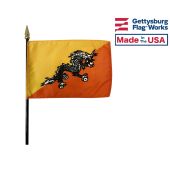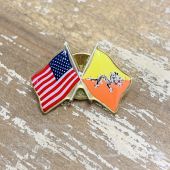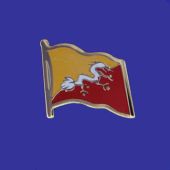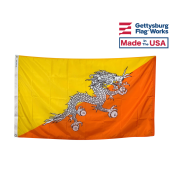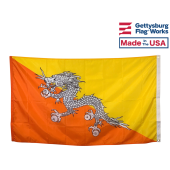Flag of Bhutan
Flag of Bhutan
The Bhutan flag is a potent symbol of the nation's unique heritage and culture. The design dates back to the middle of the 20th century, but the flag's symbolism comes from a significantly older tradition that vastly predates the modern nation.
The national flag of Bhutan is one of the national symbols of Bhutan. The flag is based upon the tradition of the Drukpa Lineage of Tibetan Buddhism and features Druk, the Thunder Dragon of Bhutanese mythology. The basic design of the flag by Mayum Choying Wangmo Dorji dates to 1947. A version was displayed in 1949 at the signing of the Indo-Bhutan Treaty. A second version was introduced in 1956 for the visit of Druk Gyalpo Jigme Dorji Wangchuk to eastern Bhutan; it was based upon photos of its 1949 predecessor and featured a white Druk in place of the green original.
The Bhutanese subsequently redesigned their flag to match the measurements of the flag of India, which they believed fluttered better than their own. Other modifications such as changing the red background color to orange led to the current national flag, in use since 1969. The National Assembly of Bhutan codified a code of conduct in 1972 to formalize the flag's design establish protocol regarding acceptable flag sizes and conditions for flying the flag.
- Capital of Bhutan: Thimphu
- Area of Bhutan: 47,000 sq. km
- Languages used in Bhutan: Dzongkha (official), Tibetan dialects, Nepalese dialects
- Religions in Bhutan: Lamaistic Buddhist, Indian and Nepalese influenced Hinduism
Colors and Symbolism of the Bhutan Flag
The field of the flag of Bhutan is diagonally bisected between gold and orange sections. A black and white is centered along the division. The orange section of the flag represents the nation's Buddhist heritage. The yellow section comes from the traditional clothing of the King of Bhutan, and it represents the state's authority and power in the mortal world. The dragon has been a symbol of Bhutan and its people for hundreds of years, and the image has its roots in the nation's traditional mythology. It is placed in the center of the flag to emphasize the equal importance of the nation's Buddhist heritage and the state's power in the modern country.
History of the Flag of Bhutan
The flag of Bhutan dates back to 1947 when it was designed by order of the nation's reigning kind. It first came to prominence on the world stage in 1949 when it was displayed during negotiations between Bhutan and India. None of the original flags from this era have survived to the present day, but descriptions have been preserved. They bore a strong resemblance to the current flag, but the dragon was a pale shade of green rather than the current black and white design. The field also featured a red section in place of the modern orange section.
An updated variation on that design came into use in 1956. It replaced the green dragon with the black and white design that can be found on the current Bhutan flag. This flag was used when the Bhutanese king made a journey across the length of his country. He traveled with a large number of ponies and had a copy of the flag placed in every tenth pony's saddle while he traveled. The flag of Bhutan was also flown whenever he stopped at night.
The modern flag came into use in 1969. The 1969 flag changed the flag's proportions in order to make it look better when it blew in the wind. The shape of the dragon was also changed to make sure that it did not face the ground when the flag was limp.

